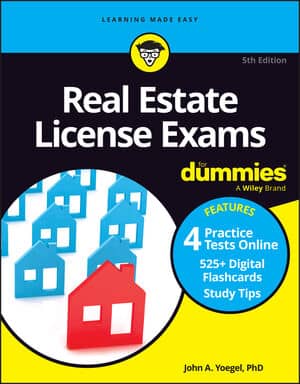You thought it took bricks and wood and nails and cement to build a house, right? It does, but the Real Estate License Exam will expect you to know about the paper involved. Building construction, residential (houses and apartments) and non-residential (pretty much everything else) alike, is regulated in most parts of the country. The regulations are in place to provide for safe and, in recent years, more energy-efficient construction.
A building code is a regulation that provides minimum standards relating to construction, electrical, plumbing, and safety materials and practices and energy-efficient items such as insulation. Building codes are adopted and administered at the local (village, town, city, and county) level.
In some states, the state government adopts a building code and then requires each local government to use that code or a stricter one. You need to find out whether your state has a statewide code and how it applies to local municipalities. In states that have an arrangement where the local government can adopt a stricter building code, this issue is a favorite question on the real estate exam.
The building code also provides details that govern the construction process, and that’s where all the paper comes in.
How to get that house built
Although the process may vary from one place to another, you’d typically follow these steps to build a house:
Draft plans.
Plans are detailed drawings of the building that usually are prepared and completed by the licensed architect or professional engineer that you hire. They usually include specifications or specs that provide written details of certain features.
File an application.
You submit the plans along with an application to the proper government agency, typically the building commissioner or inspector or code enforcement department.
Review the plans.
The building department officials review your plans to make sure they comply with all the ordinances and regulations of the municipality.
Issue a building permit.
The building department then issues you a building permit, and you now can officially begin construction.
Conduct inspections.
An official from the building department inspects your project at various points during construction. Some typical items that are inspected include the foundation, framing, insulation, and electrical and plumbing work.
Undergo final inspection.
A building official inspects the project when construction is complete.
Issue a certificate of occupancy.
When the building department is satisfied that you’ve completed the project in accordance with your plans and all the appropriate codes and regulations, it issues you a certificate of occupancy, often referred to as the C of O, which is important proof that you’ve properly completed the project. When construction involves internal modification of the house, a certificate of completion or compliance may be issued in some municipalities.
Throw a party.
State specific construction regulations
Most states have regulations concerning development. Some states have more than others. In preparing for the exam, you’re going to have to hunt around a bit in your home state to find out about your state’s development regulations.
Finding what state agencies play a part in controlling development, what the major laws are, and what issues both deal with, probably is enough; however, if you have to take a prelicensing course, pay special attention to the state agencies and laws they deal with. If you don’t have to take a course, just study the material the state gives you to prepare for the exam.
Possible development issues that your state may deal with include the following.
State roads: Find out who controls whether you get permission to put in a new driveway off of a state road. Usually it will be your state department of transportation or highways.
Fire and electrical concerns: Your state may have a special agency or department that deals with regulations for electrical and fire safety issues.
Environmental issues: Some states have adopted regulations that require consideration of environmental issues in the development of land. Although adopted by the state, they may be administered at the local municipal level.
Historic preservation: Preserving area history is another factor where states have adopted regulations but delegated authority to administer them or adopt more stringent ones to the local municipality.

